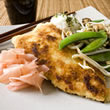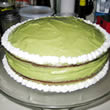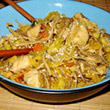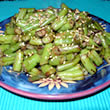Japanese Cooking Tips....
Sa Shi Su Se So
Here is a brief Japanese cultural question that is known to even easily trip up the Japanese: What is the “Sa Shi Su Se So” of basic Japanese food seasonings?
Sa-Shi-Su-Se-So in Japanese Cooking
 By: MusashiDecember 14, 2012 CategoriesShare
By: MusashiDecember 14, 2012 CategoriesShare
In Japanese cooking there are 5 basic seasonings ingredients which are essential in most Japanese cooking. They are:SATO (砂糖) Sugar, SHIO (塩) Salt, SU (酢) Vinegar, SEUYU (醤油) Soy Sauce, MISO (味噌) MisoThe order in which these ingredients are used is very important. They are listed in order of light to strong flavors. Basically, the ingredients whose flavors are most susceptible to being changed by heat are added last, for example soy sauce or miso. The way we remember this is with Sa(さ) Shi(し) Su(す) Se(せ) So(そ), which is the “s” row of the phonetic alphabets (hiragana and katakana) in Japanese.
The order is based on some experiments and practical food senses :
1. Sweet taste is difficult to penetrate, adding sugar first is usually advisable and allow more flexibility adjust the sweetness with other ingredients. If salt or soy sauce is added before sugar, it becomes very difficult for the sweet taste to seep through the food.
2. Salt is added at the early stage of cooking because of its strong permeation and high absorption nature. It is not only for flavoring but to pull moisture from vegetables and get rid of the smell in fish. It’s often used in defining the taste of the cooking.
3. Having vinegar come after salt becomes important, especially for vegetables because the vinegar will not seep in if there is too moisture in the vegetables.
4. Soy sauce and miso come last because both are fermented foods and are most susceptible to being affected by heat.
You might ask, “What about mirin or sake?”If you are adding sake for additional flavoring, it goes in before sugar. And for mirin, a type of rice wine similar to sake, is needed it will be added last after miso. Most sauces use at least three ingredients as opposed to all and there are regional variations to their use.
If you stick to this order, all your flavors will have a chance to become their richest. There are both practical reasons and chemical related reasons for this, and it is amazing how much a difference it will make to your cooking.Feel free to share your thoughts and let us know how it goes with your Japanese cooking!
The Global Pantry: Japan
http://allrecipes.com/With interest in international cuisine exploding, many home cooks are branching out and experimenting with the new, exotic ingredients they're finding in the supermarket.
The Global Pantry: Japan
http://allrecipes.com/With interest in international cuisine exploding, many home cooks are branching out and experimenting with the new, exotic ingredients they're finding in the supermarket.
Twenty-five Tastes
Creating your own take on international cuisines is easy once you've learned a few things about the core ingredients that build the dominant flavors in these diverse global cuisines.
To help spark your creativity in the kitchen, we've created some handy lists of the 25 most common ingredients you'll find in the pantries of home cooks from all over the world.
The Japanese Pantry
From precise preparation to artful presentation, no aspect of Japanese cuisine gets overlooked. Flavors, textures, colors, the overall composition and presentation of food on the plate--everything is designed to appeal to the senses.
Fish: Though Japan is a mountainous country with relatively limited agricultural output, the waters around the archipelago are brimming with sea life. Not surprisingly, seafood dominates Japanese cuisine, along with rice, soy, seaweed, and fresh vegetables and fruits.
Chicken: Chicken is popular sliced in teriyaki preparations or skewered and grilled. Chicken might also be dredged in potato starch and fried or ground and served as dumplings.
Tofu: A versatile ingredient, tofu is enjoyed in stir-fries, soups, casseroles, salads, sauces, and sandwiches. It is high in protein and an excellent meat substitute. Tofu is made by pressing curdled soy milk in a process similar to cheese-making. Smooth and creamy, the firmness of tofu varies. It is perishable, and should be refrigerated and eaten within a week of purchase. (Shelf-stable pasteurized varieties are available but are not as fresh-tasting.)

Green Tea: Tea is a crucial part of Japanese culture. Enjoyed throughout the day, green tea plays a prominent role in every meal. Formal social rituals, cha-do ("the way of tea"), have been built up around tea drinking as a transcendent philosophical experience. Unlike black tea, green tea is made without fermenting the leaves, resulting in light yellow-green color and a flavor similar to the fresh, green tea leaves. Green tea is also loaded with antioxidants and antibacterial properties that help fight cavities and gum disease.
Soy sauce: Japanese soy sauce has a different flavor than Chinese: it is fermented from half roasted, cracked wheat and half soybeans, giving it a sweetness and higher concentration of alcohol that Chinese soy sauce. Tamari is a kind of Japanese soy sauce that, like the Chinese version, is made with little or no wheat and has a rich, dark color and flavor. An incredibly versatile ingredient in Japanese cooking, soy sauce is used to flavor sauces, soups, stir-fries, and braised dishes. It is also used for marinades, for pickling, and as a condiment. Known as shoyu in Japan, soy sauce should be added to dishes at the end of the cooking process to preserve its flavors.
Sesame oil: Oil derived from tiny white sesame seeds (goya in Japanese), sesame oil has been an ingredient in Japanese cooking for centuries. Most sesame oil used in Japanese cooking is made from toasted seeds and has a rich, nutty flavor and golden color. Use sesame oil sparingly and store in a cool, dry place.
Rice wine vinegar: An important ingredient in sushi rice. Rice wine vinegar has a mild flavor, but its strong acidity helps slow the growth of food-borne bacteria. Store rice vinegar in the refrigerator or in a cool dry place. Rice vinegar is used primarily in dressings, to make pickles, and in sushi rice.
Plum wine: Fermented from green ume plums, plum wine has a pleasantly sweet and sour flavor.
Mirin: A slightly sweet rice wine similar to sake but lower in alcohol. Because of its strong flavor, it should be used sparingly in cooking. It is a common ingredient in teriyaki sauce.
Dashi: An important ingredient in Japanese cooking, dashi is a simple soup stock made from boiling water and dried kombu seaweed.

Nori Seaweed: These paper-thin sheets of dried seaweed are used for wrapping sushi. The sheets are roasted gently and are high in protein. Sliced thinly, nori makes a terrific garnish or seasoning.
Udon noodles: These thick spaghetti-like noodles are made from corn or wheat flour. Available fresh or dried, udon noodles are a mainstay in Japanese soups.
Ramen noodles: These deep-fried instant noodles are also the name of a dish consisting of noodles in broth with pieces of meat and vegetables.
Tempura batter mix: Tempura was introduced into Japan by the Portuguese in the 16th century. The word comes from quattuor tempora, Portuguese for "Ember Days," the time of year when Catholics abstain from meat. Tempura was the light batter used to fry fish and vegetables. It remains the same today.
Rice: When a Japanese person says, "Let's eat!" what they're actually saying is "Let's eat cooked rice." The expression reveals the importance of rice in Japanese cuisine and culture. Japanese rice is short-grained, but there are many regional variations. There are three kinds of rice: polished white, semi-polished white and unpolished brown. The most popular is the polished white version, though it has the least nutrients.
Panko: These jagged breadcrumbs are essential for fried foods, creating a crisp coating; they're coarser than breadcrumbs used in Western cooking.

Mayonnaise: Japanese borrowed from the French and made mayonnaise their own. Mayonnaise is used in some sushi preparations and as a condiment for savory omelets (okonomiyaki).
Miso: Miso is a very important flavoring ingredient in Japanese cooking, added to soups, sauces, marinades, dips, salads and main dishes, and provided as a table condiment. It is made from cooked grains (rice, barley or soybeans) that are fermented with a starter. It is then mixed with ground soybeans and aged in barrels for months or even years. Miso paste's depth of flavor comes from its yeasts and lactic acid bacteria: in general, the darker the miso, the stronger the flavor. Miso paste should be stored in the refrigerator.
Sesame seeds: Mild and nut-like, sesame seeds are used to add texture and flavor to a variety of Japanese dishes. Their flavor intensifies when toasted.
Daikon: A large root with a sweet flavor and crisp texture, daikon are used in salads, in stir-fries, and pickled as a garnish.
Japanese Cucumbers: These long, thin cucumbers have thick skins that sport tiny bumps all over them. They are crisp and relatively seedless. Japanese cucumbers originated in the Himalayan region.
Ginger: Ginger made its way to Japan via China many centuries ago. Slivered or sliced thin, ginger is frequently added to Japanese stir-fries, salads and soups. Store leftover ginger root in the refrigerator wrapped in plastic wrap. Pickled ginger--paper-thin pink slices--is traditionally eaten with sushi. Because of its antiseptic qualities, pickled ginger is thought to combat potential food-borne bacteria.
Shiitake mushrooms: Fresh shiitake mushrooms are grilled or served in soups and stir-fries. Dried shiitakes are more flavorful and should be brought back to life in a soak of warm water. Add the soaking liquid to soups and stir-fries.
Enoki mushrooms: Looking a bit like a handful of long white carpentry nails, enoki mushrooms grow in clumps; they have a slightly crunchy texture and mild flavor. Use them in salads or added to soups and other hot dishes at the end of cooking.
Japanese eggplant: Smaller and thinner than European eggplants, Japanese varieties have thin skins and a delicate flavor.

Twenty-five Tastes
Creating your own take on international cuisines is easy once you've learned a few things about the core ingredients that build the dominant flavors in these diverse global cuisines.
To help spark your creativity in the kitchen, we've created some handy lists of the 25 most common ingredients you'll find in the pantries of home cooks from all over the world.
The Japanese Pantry
From precise preparation to artful presentation, no aspect of Japanese cuisine gets overlooked. Flavors, textures, colors, the overall composition and presentation of food on the plate--everything is designed to appeal to the senses.
Fish: Though Japan is a mountainous country with relatively limited agricultural output, the waters around the archipelago are brimming with sea life. Not surprisingly, seafood dominates Japanese cuisine, along with rice, soy, seaweed, and fresh vegetables and fruits.
Chicken: Chicken is popular sliced in teriyaki preparations or skewered and grilled. Chicken might also be dredged in potato starch and fried or ground and served as dumplings.
Tofu: A versatile ingredient, tofu is enjoyed in stir-fries, soups, casseroles, salads, sauces, and sandwiches. It is high in protein and an excellent meat substitute. Tofu is made by pressing curdled soy milk in a process similar to cheese-making. Smooth and creamy, the firmness of tofu varies. It is perishable, and should be refrigerated and eaten within a week of purchase. (Shelf-stable pasteurized varieties are available but are not as fresh-tasting.)
 |
Green Tea: Tea is a crucial part of Japanese culture. Enjoyed throughout the day, green tea plays a prominent role in every meal. Formal social rituals, cha-do ("the way of tea"), have been built up around tea drinking as a transcendent philosophical experience. Unlike black tea, green tea is made without fermenting the leaves, resulting in light yellow-green color and a flavor similar to the fresh, green tea leaves. Green tea is also loaded with antioxidants and antibacterial properties that help fight cavities and gum disease.
Soy sauce: Japanese soy sauce has a different flavor than Chinese: it is fermented from half roasted, cracked wheat and half soybeans, giving it a sweetness and higher concentration of alcohol that Chinese soy sauce. Tamari is a kind of Japanese soy sauce that, like the Chinese version, is made with little or no wheat and has a rich, dark color and flavor. An incredibly versatile ingredient in Japanese cooking, soy sauce is used to flavor sauces, soups, stir-fries, and braised dishes. It is also used for marinades, for pickling, and as a condiment. Known as shoyu in Japan, soy sauce should be added to dishes at the end of the cooking process to preserve its flavors.
Sesame oil: Oil derived from tiny white sesame seeds (goya in Japanese), sesame oil has been an ingredient in Japanese cooking for centuries. Most sesame oil used in Japanese cooking is made from toasted seeds and has a rich, nutty flavor and golden color. Use sesame oil sparingly and store in a cool, dry place.
Rice wine vinegar: An important ingredient in sushi rice. Rice wine vinegar has a mild flavor, but its strong acidity helps slow the growth of food-borne bacteria. Store rice vinegar in the refrigerator or in a cool dry place. Rice vinegar is used primarily in dressings, to make pickles, and in sushi rice.
Plum wine: Fermented from green ume plums, plum wine has a pleasantly sweet and sour flavor.
Mirin: A slightly sweet rice wine similar to sake but lower in alcohol. Because of its strong flavor, it should be used sparingly in cooking. It is a common ingredient in teriyaki sauce.
Mirin: A slightly sweet rice wine similar to sake but lower in alcohol. Because of its strong flavor, it should be used sparingly in cooking. It is a common ingredient in teriyaki sauce.
Dashi: An important ingredient in Japanese cooking, dashi is a simple soup stock made from boiling water and dried kombu seaweed.
 |
Nori Seaweed: These paper-thin sheets of dried seaweed are used for wrapping sushi. The sheets are roasted gently and are high in protein. Sliced thinly, nori makes a terrific garnish or seasoning.
Udon noodles: These thick spaghetti-like noodles are made from corn or wheat flour. Available fresh or dried, udon noodles are a mainstay in Japanese soups.
Ramen noodles: These deep-fried instant noodles are also the name of a dish consisting of noodles in broth with pieces of meat and vegetables.
Tempura batter mix: Tempura was introduced into Japan by the Portuguese in the 16th century. The word comes from quattuor tempora, Portuguese for "Ember Days," the time of year when Catholics abstain from meat. Tempura was the light batter used to fry fish and vegetables. It remains the same today.
Rice: When a Japanese person says, "Let's eat!" what they're actually saying is "Let's eat cooked rice." The expression reveals the importance of rice in Japanese cuisine and culture. Japanese rice is short-grained, but there are many regional variations. There are three kinds of rice: polished white, semi-polished white and unpolished brown. The most popular is the polished white version, though it has the least nutrients.
Panko: These jagged breadcrumbs are essential for fried foods, creating a crisp coating; they're coarser than breadcrumbs used in Western cooking.
 |
Mayonnaise: Japanese borrowed from the French and made mayonnaise their own. Mayonnaise is used in some sushi preparations and as a condiment for savory omelets (okonomiyaki).
Miso: Miso is a very important flavoring ingredient in Japanese cooking, added to soups, sauces, marinades, dips, salads and main dishes, and provided as a table condiment. It is made from cooked grains (rice, barley or soybeans) that are fermented with a starter. It is then mixed with ground soybeans and aged in barrels for months or even years. Miso paste's depth of flavor comes from its yeasts and lactic acid bacteria: in general, the darker the miso, the stronger the flavor. Miso paste should be stored in the refrigerator.
Sesame seeds: Mild and nut-like, sesame seeds are used to add texture and flavor to a variety of Japanese dishes. Their flavor intensifies when toasted.
Daikon: A large root with a sweet flavor and crisp texture, daikon are used in salads, in stir-fries, and pickled as a garnish.
Japanese Cucumbers: These long, thin cucumbers have thick skins that sport tiny bumps all over them. They are crisp and relatively seedless. Japanese cucumbers originated in the Himalayan region.
Ginger: Ginger made its way to Japan via China many centuries ago. Slivered or sliced thin, ginger is frequently added to Japanese stir-fries, salads and soups. Store leftover ginger root in the refrigerator wrapped in plastic wrap. Pickled ginger--paper-thin pink slices--is traditionally eaten with sushi. Because of its antiseptic qualities, pickled ginger is thought to combat potential food-borne bacteria.
Shiitake mushrooms: Fresh shiitake mushrooms are grilled or served in soups and stir-fries. Dried shiitakes are more flavorful and should be brought back to life in a soak of warm water. Add the soaking liquid to soups and stir-fries.
Enoki mushrooms: Looking a bit like a handful of long white carpentry nails, enoki mushrooms grow in clumps; they have a slightly crunchy texture and mild flavor. Use them in salads or added to soups and other hot dishes at the end of cooking.
Japanese eggplant: Smaller and thinner than European eggplants, Japanese varieties have thin skins and a delicate flavor.
 |
Washing Rice
This is the traditional Way of washing Japanese rice. Japanese rice comes with a lot of rice flower or powder on it.. and sometimes.. there are small stones.. as well.. Washing this way.. makes sure that the power and any foreign particles are removed before cooking.

Step 1:
Place rice in a bowl or a pan from a rice cooker.

Step 2:
Add water double to the amount of rice and discard immediately without stirring.

Step 3:
Stir the rice without water about ten times with a rice spoon.

Step 4:
Add water to a level about 1 in. above the rice and again discard immediately without stirring.
Step 5:
Repeat (Step 4) three times.
No comments:
Post a Comment